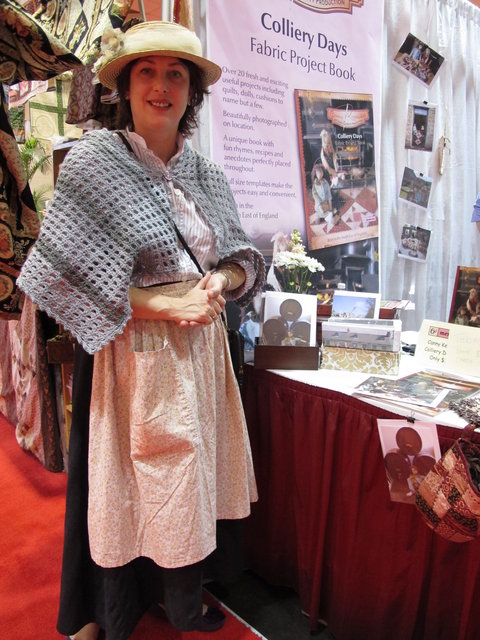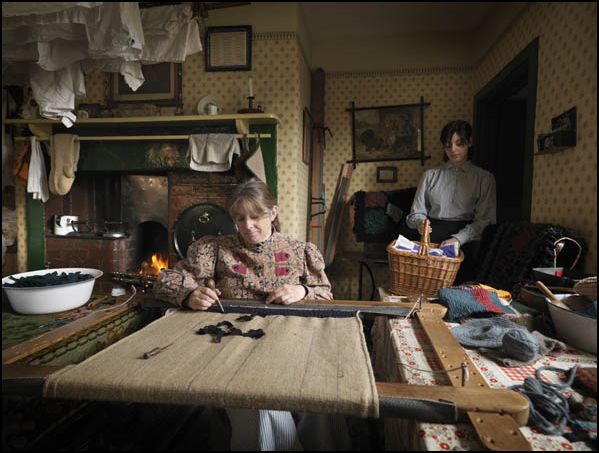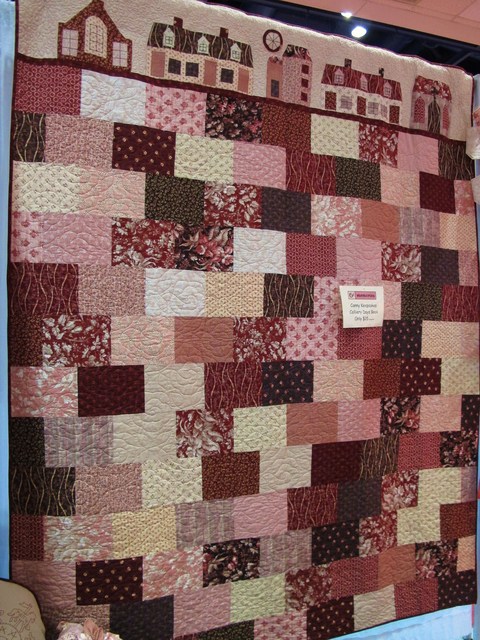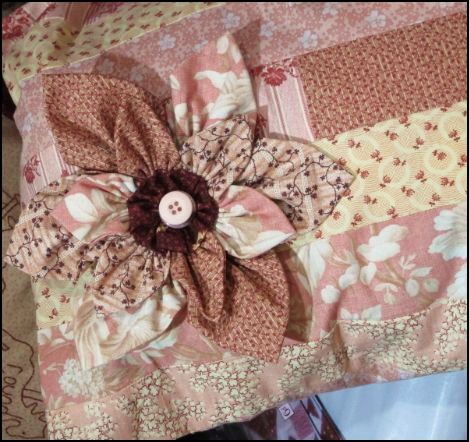

Debbie Johnson (left) and Kim Suleman (right) dressed in their shawl and hat 'for out in town'.
A Step Back in Time
By Lilo Bowman
The first visit in our Around the Globe tour is with co-authors Debbie Johnson and Kim Suleman (writing as "Betty" and "Florrie"), who charmed everyone at the show in Houston with their warm personalities and their dress, typical of the clothing worn by middle-class women from a colliery village in the North East of England during the early 1900s. Debbie and Kim's book, Colliery Days: A Fabric Project Book, includes beautiful photography shot in miners' cottages, and features old patterns inspired by the Beamish Open Air Museum interpreted in updated designs. The book also includes childhood memories, recipes, and poems shared by "Betty" and "Florrie," who grew up in a nearby colliery.
The Beamish Museum, rebuilt and set in 1913, is a living, working museum dedicated to sharing the history of North East England by allowing visitors to step back into another time. (Think Williamsburg, VA). Come along as we share stories and a few of the many fabric projects from Colliery Days inspired by the rich heritage of the Beamish Museum.

Interior of a Pit Cottage home. Photo courtesy of the Beamish Museum
Life in a colliery (mining) village home was filled with lots of activity from sun up to sun down. A typical family might have as many as 10 to 12 children to feed and clothe, which meant that all able hands were busy working in and around the home while the older male members were off working in the mines. When daily chores were completed, the woman of the house would work on quilts which--when completed--would be sold to the more affluent families of the village. Girls as young as four or five years old would help their mothers with sewing and quilting as a way of adding to the much-needed family income.

Debbie and Kim's charming Pitfield Street Quilt design was inspired by the stone floor pattern found in the typical cottage. The applique buildings represent the various buildings of the village.
Due to their close living quarters and communal water sources, pit communities were close knit, and families relied heavily upon each other. A typical row of connected cottages included a large garden with a 'nettie' or earthen closet (toilet)--emptied weekly--at its far end.The garden provided space to grow food for the family. Items not grown in the family garden could be purchased in the village co-op, which offered everything one might need to run a household, including mining equipment, which pitmen were expected to provide for themselves. It was said that the co-op could provide everything one might need from birth to the death.
Along with stocking necessities, the co-op also operated as a bank, building society, and provided reading rooms and meeting rooms for social functions, including events supporting the women's suffrage movement. As with many political movements, messages often were passed secretly so as not to arouse suspicion. The adorable fabric corsage shown below harkens back to the days when the women of the time would make corsages in suffragette colors to let others "in the know" see that they shared a common cause. "We have made a couple of the corsages in the suffragette colours, using a subtle Green-(Give), Violet-(Votes), White-(to Women)," the co-authors note. Debbie and Kim's fabric versions would work equally well on a quilt, a lapel, or hat brim.

A Bold Corsage from Colliery Days: A Fabric Project Book
With little extra money, a family made use of every piece of cloth available. Fabrics that had outlived their use as hand-me-down clothing would be cut into strips to be used for "proggy mats." These fabric mats were a working-class home's alternative to carpeting during the mid-20th century, protecting feet from cold stone flooring. "The basic requirements to make a mat were a frame and a hook or progger (which looks something like a short, fat, knitting needle)...made by the local men. The backing material was hessian (burlap), from old sacks...Trousers, jackets, and coats made from hardwearing tweeds or worsted were best, navy blue, black, or brown were the commonest colours available." The fabric strips were pushed and looped through the hessian (burlap) backing. All members of the family would help with the cutting, designing, and construction. Debbie and Kim's nod to history is the adorable Proggy Tea Pot Mat shown below.

Proggy Tea Pot Mat from Colliery Days: A Fabric Project Book
While life in the colliery village was hard, dangerous, and often tragic, there were times when the day-to-day grind was suspended, if only briefly. The Fair, loved by all, offered treats, sweets, and rides to delight both young and old. Electric and motorized vehicles were still relatively new at this time, so a ride on a merry-go-round was a special treat for the youngsters of the village. The redwork Merry-Go-Round Cushion shown here brings back memories of the colorfully painted horses that delighted those village children.

Merry-Go-Round Cushion from Colliery Days: A Fabric Project Book
Through the vision of its founder and first director, Frank Atkinson, the Beamish Open Air Museum offered--and continues to offer--visitors the unique opportunity to experience a time and place that was very quickly changing. With the disappearance of the coal and shipping industry, so too were the history and traditions of this part of England being lost to time. Through Atkinson's dogged determination and community outreach, what began with 22 huts and hangars filled with items donated by the local residents now is a "living museum" set on 300 acres. "Unlike many museums, the idea at Beamish is not to store objects and then to occasionally put them into exhibitions; it is to save, store, and then permanently display the objects in the context or buildings in which they would have been originally seen." (excerpt from Beamish The Living Museum of the North)
Tour the Beamish Museum in pictures. ![]()
To learn more about or to visit the Beamish Museum, visit their website here.
Thank you to Debbie, Kim, and the Beamish Museum for sharing this little bit of North East England with us all.
References:
Beamish The Living Museum of the North available here.
Colliery Days Fabric Project Book, available here.
Debbie Johnson at Letters tied with blue click here.
Kim Suleman at The Fat Quarters shop click here.




.jpg)


